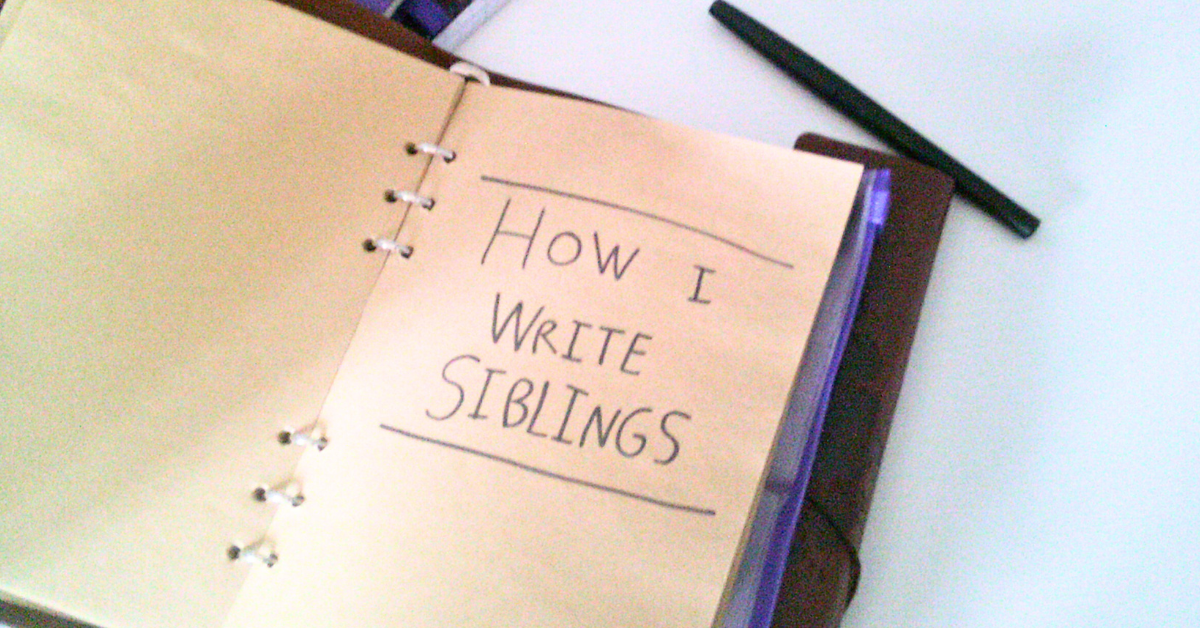Intro
There are a lot of siblings in my stories. Come to think of it, most of my main characters have had at least one sibling, sometimes more. A lot of this probably comes from growing up with siblings myself, but there’s also just the simple fact that siblings can add so much to the story—more than a lot of people give them credit for, I think. For example, a sibling can make a great built-in partner for a character or, if they don’t get along all that great, maybe a great built-in foil.
But writing siblings isn’t always easy, and I’d imagine it’s especially tricky if you don’t happen to have siblings yourself. So today I’m going to share with you some of the stuff I keep in mind when I’m writing them, and some of my strategies for making them—and their relationships—believable.
So let’s get started!
Sibling Personalities
Like with all characters, personality pretty much always comes first when I’m trying to create siblings. The personality kind of sets the stage for just about everything to do with the character—how they talk, act, dress, and so on. And, in the case of siblings who have grown up together, their personalities would likely be shaped by the same things—though possibly with very different results for each sibling.
Like, say that we’ve got three siblings who were raised together in a pretty isolated environment, with little contact with the outside world. (Maybe they’re part of some sort of royal family, if you don’t mind my going fantasy with this, and it’s for their own protection.) For one sibling, the isolation might make them shy and slow to trust strangers. For another, maybe it makes them more adventurous and curious about what could be out there. And for the third, maybe it makes them super disconnected and dismissive to any matters that affect anything outside their immediate surroundings. The reason for all of their distinct traits is the same—isolation—but that isolation obviously affected them all in different ways, bringing about different traits.
Obviously, it doesn’t necessarily have to affect all of them differently—maybe the isolation could make two, or even all three, of them adventurous instead of just one—but, if I were to do that, I’d want to be extra sure that I come up with other ways of making them different and distinct from each other. Because, like with any group of characters, you want to make sure that they aren’t all the same—and, where siblings are concerned, the differences between them could easily be very intentional on the characters’ parts.
While siblings do—and should—have at least some things in common, they’re also often very different. Sometimes this just happens by accident, but sometimes it’s by intention—or maybe it can even be a mix of both. It’s pretty common for kids to want to find ways to distinguish themselves from their siblings, whether it’s by purposely choosing different favorite colors or whatever from their siblings, or by purposely behaving differently. (You know, like when one sister says “My favorite color’s pink!” and then the other one says “My favorite color’s also pink!” and then at some point later the first one goes “…Actually, my favorite color’s purple.”) A lot of the time, stuff like this might be unconscious—especially if they’re little—but it is kind of at the back of their mind. They want to distinguish themselves, whether it’s because they feel like it would get them more attention, or because they just want to feel more individual, or for some totally different reason that I can’t think of. Whatever the reason is for that specific character, the result is the same.
So, in short, if the siblings have a lot of similarities, be sure to make them different in some pretty big ways too. You don’t want people—or yourself—to not see much to distinguish them from each other and, as a result, be constantly getting them mixed up.
Sibling Relationships
The sorts of relationships my characters have with their siblings can vary dramatically—ranging from “Oh, I’d die to protect you!” to “I’ll hunt you to the ends of the earth just to kill you!”—but hey, it’s a diverse mix.
Which is actually a good thing to keep in mind when writing a relationship between siblings: No sibling relationship is exactly the same. And, regardless of whether they love or hate each other—or maybe a little bit of both—no sibling relationship is a simple all-good or all-bad situation. Like any long-standing relationship, there are ups and downs, and including these ups and downs in your story—or at least the characters’ backstories—can help make it feel way more realistic. For example, maybe the siblings who hate each other’s guts now were super close when they were kids, or maybe the siblings who usually get along so well had some sort of serious disagreement in the past that almost tore them apart.
No matter what the relationship is like, I usually try not to over exaggerate it, unless I think it would be appropriate for the characters in question and the story that they inhabit. Even if two siblings dislike each other, it’s kind of unrealistic—and often a little annoying—if they’re constantly arguing with or nagging at each other. And, even if two siblings love each other with the whole of their beings, they usually wouldn’t be all openly mushy about it all the time, if they ever are. I can include these sorts of scenes, of course, but I try to be selective about when they happen. Not only does this keep things from feeling too exaggerated or annoying, but it can also make the scenes feel more impactful if they aren’t something that happens all the time.
Most of the time, I want to be more subtle. If siblings dislike each other, I can show some tension whenever they’re in a room together. If they love each other, I can make a point of regularly showing them hanging out or having a casual chat. A lot of their interactions will largely depend on their personalities and the current state of their relationship, but these are just some examples.
Sibling Interactions
Another key part of sibling relationships that I want to highlight is how the siblings in question interact and talk to each other—which I think is something that is often overlooked in fiction. A lot of people talk differently to their siblings than they do when they’re talking to anybody else. If they’re close—and especially if they’re also close in age, though they don’t necessarily have to be—they might be a little more casual and playful when they’re talking to each other. Maybe they tend to joke around or reference some of their shared interests whenever the opportunity arises (like if there’s some sort of movie or video game or something that they’re both into, or were into when they were kids).
Interactions between siblings who aren’t particularly close are usually trickier for me, regardless of whether the distance between them is intentional because they don’t like each other, or whether it’s just because of something that was beyond their control when they were growing up, like a big age gap between them or being raised in different ways. If they don’t like each other, maybe they’re outright hostile, or maybe simply indifferent, depending on how deep their dislike for each other goes. If they just aren’t very close for whatever reason, this could also be a reason for indifference, or maybe even a little awkwardness, if one or both of them wants to be closer than they are, but aren’t sure how to go about it.
Outro
That’s all for today. I hope that this was interesting and that, if you came here looking for tips on how to write siblings, you found it helpful. Thank you for reading, and be sure to check back next month for the next writing post!












